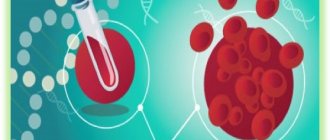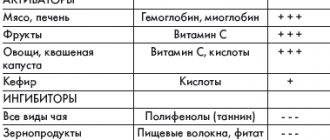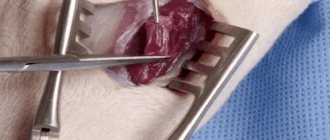Update date: 05/12/2020 15:07:31 209736 Share:
Author: Arkady Sagalovich
*Review of the best according to the editors of simplerule.ru. About the selection criteria. This material is subjective in nature, does not constitute advertising and does not serve as a purchase guide. Before purchasing, consultation with a specialist is required.
Iron-containing preparations are usually always sold without a prescription, since for some reason it is believed that they are not capable of harm if they are prescribed simply for prevention. Therefore, many doctors can find abuse of indications for prescribing iron “right and left.” However, any prescription of medications just like that, including conventional multivitamin complexes, can cause more harm than good. Iron-containing preparations must be prescribed either if there is anemia or anemia, or if increased iron consumption is planned, for example, during pregnancy.
But even if the patient is diagnosed with anemia, sometimes you need to start not with iron supplements at all, but by looking for the cause. And if the cause of the resulting anemia is not identified, then this treatment is worthless. Let's imagine that a patient has chronic blood loss through the intestines because there are bleeding polyps, a tumor, or parasites. Yes, there are special parasites, hookworms, which literally just suck blood, they feed exclusively on human blood. Therefore, attempting to prescribe iron supplements to such a patient with chronic and constant blood loss would be a grave mistake. He needs to be given anthelmintics, and then, after the parasites are destroyed, even a proper and balanced diet can lead to restoration of iron levels. What quantitative indicators can indicate normal iron metabolism in humans? Here they are.
Indicators of normal iron metabolism
The most important indicator of red blood and iron levels, although indirect, but simple and important, is the concentration of hemoglobin. If it is lower than 130 g per liter for men, 120 g per liter for women, or 110 g per liter for pregnant women, then the condition is anemia. In the same case, if the hemoglobin level is less than 90 g/l, then the person should “automatically” go on sick leave, since he cannot work, especially hard work, physically, with such a hemoglobin concentration.
- Other direct indicators of iron metabolism are:
- ferritin blood plasma,
- transferrin,
- percentage of transferrin saturation with iron;
- free serum iron concentration.
We deliberately do not provide standards for men and women in order to save the reader from the temptation to replace seeing a doctor with various types of self-diagnosis. What are the symptoms and signs of iron deficiency anemia that can alarm a person and force him to go get tested?
Fenyuls
Release form: capsules coated with a compound that forms a semi-permeable film of a certain thickness. This ensures a gradual release of iron.
If there are current instructions on the drug’s website, then it seems that this is the only iron supplement that can be dispensed without a doctor’s prescription.
But I wouldn't do it, and here's why.
Fenyuls contains ferrous sulfate and a number of vitamins (B1, B2, B6, PP, ascorbic acid, calcium pantothenate). All this, as the manufacturer claims, improves iron absorption and prevents the formation of free radicals.
But there are more side effects, since in addition to the side effects for iron, side effects for vitamins have been added: allergic reactions, dizziness, tachycardia, sweating, numbness of the extremities, an increase in the number of platelets, leukocytes, increased blood sugar levels, etc.
Maybe that's why the manufacturer is so careful with the recommended dosage? Pure iron in 1 capsule - 55 mg. Take 1-2 capsules per day. This dosage is more suitable for the prevention of anemia or the treatment of latent iron deficiency.
Contraindicated for children, allowed for pregnant and lactating women.
Symptoms of iron deficiency anemia (IDA, sideropenic syndrome)
Symptoms of iron deficiency anemia can, to one degree or another, appear much earlier than a person gets ready to get tested. Most often the skin and its appendages are affected, that is, nails and hair, the gastrointestinal tract, as well as the cardiovascular and nervous systems. In descending order of frequency of symptoms of long-term, slowly developing anemia, the signs are arranged as follows:
- increased skin dryness,
- excessive striations, layering and fragility of nails, changes in their structure and shape;
- hair begins to grow more slowly, and the ends of the hair split;
- mild fatigue and weakness appear, which intensifies as anemia progresses;
- shortness of breath on exertion, and as it progresses, pallor;
- if there is cyanosis of the nasolabial triangle, that is, its cyanosis, cyanosis of the earlobes or the tip of the nose, then this may not indicate anemia, but some kind of cardiovascular pathology, for example, a heart defect with a decrease in oxygenation of the capillaries with oxygen;
- an earthy complexion along with pallor may indicate the presence of malignant neoplasms;
- patients with anemia sometimes complain of a special, painful sensation of smells, hyperosmia, and taste perversion. Sometimes it is common to eat chalk, tooth powder or paste, raw cereals, and so on;
- fainting and dizziness, especially during a rapid transition from a horizontal to a vertical body position, can also be a serious sign of progressive anemia.
Typically, any anemia in its development goes through several stages before it becomes clinically and laboratory noticeable. The main stage from which the anemic process begins is the prelatent, or latent phase. There is no clinically significant iron deficiency yet; reserves that should be in the body are consumed to cover it. Then ferritin and transferrin begin to decrease, the concentration of free iron in the blood serum begins to change, and only then, as a gross laboratory symptom of anemia, the concentration of hemoglobin also decreases, since it is in the hemoglobin molecule that there is a special structure - heme, which contains iron.
Maltofer
Release forms for oral administration: drops, syrup, chewable tablets.
Main feature: iron hydroxide is combined with carbohydrates. This complex is called: “Iron hydroxide polymaltosate.” In articles and instructions it is referred to by the abbreviation HPC (hydroxide-polymaltose complex).
Its structure is similar to that of the natural iron compound ferritin. Thanks to this, it can connect with the transport protein, which delivers iron from the intestines to the blood.
GPC is stable. “pure” iron is not released into the gastrointestinal tract, and therefore there are significantly fewer adverse reactions when using it.
Pregnant and breastfeeding women can. Maltofer Fol will be optimal , which contains folic acid necessary for normal growth and development of the fetus.
Children: Maltofer drops, syrup - from birth, tablets - from 12 years.
Adverse reactions: nausea, constipation, diarrhea, dark stool, rash, itching, discoloration of tooth enamel.
Drug interactions - no.
There are no food interactions.
How to take: for the treatment of IDA, adults take 40-120 drops or 10-30 ml of syrup or 1-3 tablets per day. (100-300 mg pure iron) during or after meals. Chewable tablets can be swallowed as usual.
Maltofer in the form of drops or syrup can be mixed with fruit juice, vegetable puree, and milk mixture.
Anemia risk groups
We have already indirectly mentioned some of the reasons for the development of anemia syndrome, such as bleeding, diseases of the stomach and intestines, and helminthic infestations. It should especially be remembered that children and pregnant women who have an increased need for iron form a risk group. Pregnant women need excess iron due to its high consumption for the construction of the baby's blood, children are actively growing, and women themselves, even those who are not pregnant, are also at risk, and specifically in reproductive age. After all, even normal menstrual bleeding is nothing more than “planned loss of iron.”
As soon as a newborn is born, the mother spends about 300 mg of iron during her pregnancy to build his body and synthesize his blood, using up her own reserves. And then, after birth, the baby's only source of iron will be mother's milk. Therefore, the lactation period, which begins immediately after pregnancy, is a continuation of the increased load on the woman’s body and increased iron consumption. If a child is fed on artificial formulas, then they must contain a certain amount of easily digestible iron.
The active period of construction of the child’s skeleton, elongation of the body requires an increase in its mass, and therefore the volume of circulating blood. And some mild signs of anemia, both laboratory and clinical, can occur in half of all children, but they are especially pronounced in girls. After all, in girls, during the period of active growth, the first menstruation, or menarche, begins, and then the loss of iron with menstruation becomes planned.
Totema
Release form: solution for oral administration. 1 ampoule - 50 mg of pure iron.
Why is the liquid form better?
The fact that the solution is more evenly distributed throughout the mucous membrane of the digestive tract, and the likelihood of irritation is reduced.
Secondly, this form is good for those who do not know how to swallow tablets, or for bedridden patients.
Another advantage of the drug Totema: it contains a safer iron salt - gluconate. The risk of side effects is less.
Fourthly, Totema contains copper and manganese, which improve iron absorption.
Children – from 3 months.
Pregnant women can.
Caution for patients with diabetes mellitus, because For taste, a lot of all sorts of chemical rubbish has been added to it. This is why I don't like liquid forms. In addition to the active and auxiliary substances necessary for stability, they contain all sorts of flavorings, dyes, sweeteners, etc., so the likelihood of allergic reactions is higher.
How to take: the contents of the ampoule should be dissolved in plain or sweetened water and drunk before meals. To treat IDA, take 1-2 ampoules 2 times a day. This is 100-200 mg of iron per day.
Basic principles of treating anemic syndrome without drugs
Naturally, the intensity of treatment for anemic syndrome, as we have already understood, depends on the causes. If this is bleeding and decay of tumor tissue, then emergency surgery is needed; if it is helminthiasis, then this is the prescription of anthelmintic drugs, but we will leave difficult situations for specialists. Let's consider a classic example of increased iron consumption in a pregnant woman, which must first be compensated for by dietary correction.
And if there are clinical, or even more so laboratory, signs of anemia, then you can no longer do without medications, but a diet can compensate for low-level iron deficiency, if we are simply talking about depletion of reserve reserves. On average, we receive about 20 mg of elemental iron every day with food, and about 10 times less is absorbed: 2 mg. And if you modify the diet, you can improve not only the supply of iron from food, but also its absorption, but not by more than 30%.
- Non-medicinal principles for treating iron deficiency using diet therapy and balanced nutrition are as follows:
- it is necessary to increase the intake of beef and fish liver, eggs and meat, natural products. Boiled, dietary meat is preferable rather than refined sausages;
- you should not rely on fresh apples as a legendary “source of iron”: no more than 5% of iron is absorbed from them,
- the presence of folic acid, vitamin C, or ascorbic acid, as well as copper in the diet increases the absorption of iron. This is precisely what the effect of complex iron-containing preparations, for example, Totems, which will be discussed later, is based on.
- Various tannins, such as tea tannin, oxalates, phosphates and calcium, reduce the availability of iron to the intestines and reduce its absorption. Therefore, regular consumption of strong tea can contribute to the occurrence of iron deficiency;
- If dairy products are consumed, they must be consumed separately from meat products, since milk contains calcium.
Which iron valence should you prefer? Both divalent and trivalent iron enter our body. But our body itself is well versed with these types of iron atoms, and oxidation and reduction processes occur with them in the body. As a result, the valency of the iron atoms changes. So, in order for iron to contact ferritin, it must have a valence of 3 plus, and hemoglobin contains divalent iron.
Tardiferon
Release form: available in the form of film-coated tablets with prolonged release of the active substance.
The composition again contains ferrous sulfate.
Differences from the drug Sorbifer: a smaller dosage of pure iron in one tablet (80 mg versus 100 mg), so you will have to wait longer for the effect. No ascorbic acid.
Children - from 6 years old.
Pregnant and lactating women are allowed.
Standard therapeutic dosage for adults: 1-2 tablets. per day (80-160 mg of iron).
Pharmacotherapy of anemic syndrome
Treatment should continue under the supervision of tests, and on average, oral replenishment of iron stores with medications lasts about 3-5 months, under the supervision of a doctor. In this case, of course, it is necessary to initially make sure that the loss of iron during treatment does not exceed the norm, otherwise the treatment will be useless.
In addition, it is necessary to strictly adhere to the principles of treatment of iron deficiency anemia. If iron deficiency anemia is diagnosed, and laboratory indicators indicate this, this means that diet alone is not enough. Even with the greatest saturation of it with iron, it is unlikely that more than 3 mg can be absorbed into the body. Modern medications can absorb 10 or even 20 times more iron than with the most balanced and saturated diet.
In most cases, for anemia, oral medications are sufficient, and blood transfusion, that is, blood transfusion of red blood cells, will be needed when hemoglobin decreases to 50 or 40 g per liter. Of course, this is a very severe anemia, and patients should not be subjected to it. Therefore, you need to try to prescribe iron as early as possible, and for a fairly long period of time, in order not only to eliminate the symptoms of anemia, both laboratory and clinical, but also to create a reserve of iron in the body, which was wasted in the initial, latent stages. This means that after normalizing the hemoglobin level and obtaining quite favorable tests, there is no need to stop treatment. It usually takes another two to three months, when a reserve of iron is created in the body, and half doses of drugs that managed to cure anemia are prescribed. If the growth of iron reserves in the body occurs slowly, then it is necessary to take additional medications, for example, multivitamins.
Various iron-containing drugs also, in turn, contain either ferrous or trivalent iron. Therefore, you can take both medications containing divalent and ferric iron. It is usually believed that when it comes to organic iron compounds, they are absorbed better, and iron compounds with maltose, ferrous gluconate, are still not as harsh as inorganic compounds of this metal, such as ferrous sulfate. But that is why organic iron compounds are a little more expensive.
All the drugs listed below are over-the-counter and can be purchased over the counter at pharmacies. All of them are included in national and international clinical guidelines for the treatment of anemia and sideropenic syndrome, and all are oral, that is, prescribed by mouth. That is, we will not consider medications containing iron for intravenous use, such as Venofer and Cosmofer. They are used in specialized settings, such as in patients on dialysis.
For medicines, the INN, that is, the international nonproprietary name, will be called first, and then the commercial name. The price is valid for the end of March 2021 for pharmacies of all forms of ownership in the Russian Federation. Almost all iron preparations are imported, and they have very few or no domestic analogues.
Aktiferrin
Oral dosage forms: drops, syrup.
Previously, there were also capsules, but now I don’t see them in the assortment of Russian pharmacies.
The composition contains ferrous sulfate, which, let me remind you, is characterized by maximum toxicity, and the amino acid serine. It improves iron absorption, since only 10-15% of ferrous iron is absorbed through the mucous membrane of the small intestine.
(And trivalent without helpers is not absorbed at all).
Pregnant and lactating women can.
Children: syrup from 2 years, drops from birth.
The dose is calculated per kg of weight.
The course of treatment is at least 8 weeks.
After hemoglobin returns to normal, you need to continue taking the drug for the same amount of time to replenish iron reserves.
What's not to like about Aktiferrin?
The manufacturer's instructions indicate the iron content in 100 ml of syrup or drops. This means that the doctor must calculate the daily dosage, taking into account the child’s weight and iron deficiency, which is determined by the formula. And if he is not good at mathematics, it is easy to make a mistake and either overdo the dose, or vice versa.
In the first case, this threatens with intoxication, in the second - too long a course of treatment.
Rating of popular iron-containing drugs for the treatment and prevention of anemia
| Nomination | Place | Name of product | Price |
| The best iron supplements | 1 | Iron hydroxide polymaltosate (Ferrum Lek, Maltofer) | 297 ₽ |
| 2 | Ferrous fumarate (Ferretab comp) | 412 ₽ | |
| 3 | Iron gluconate+manganese gluconate+copper gluconate (Totema) | 547 ₽ | |
| 4 | Iron sulfate + ascorbic acid (Sorbifer Durules, Tardiferon, Ferrogradumet) | 394 ₽ | |
| 5 | Iron protein succinylate (Ferlatum) | 855 ₽ | |
| 6 | Iron sulfate + ascorbic acid + multivitamins (Fenuls) | 271 ₽ |
Iron hydroxide polymaltosate (Ferrum Lek, Maltofer)
Rating: 4.9
Ferrum Lek is a trivalent preparation of iron, in the form of hydroxide bound to the organic residue of the polymerized sugar maltose. You can buy chewable tablets at the pharmacy for an average price of 275 rubles per pack of 30 tablets, or you can buy them in syrup form. The drug is produced by Lek from Slovenia. This medicine is only produced in Slovenia, and the registration certificate is owned by the Sandoz company from Switzerland. And this is a guarantee of quality. In addition to chewable tablets, you can also purchase 100 milliliters of syrup along with a measuring spoon, but the tablets are more convenient for adults to take.
In terms of iron, 1 tablet contains 100 mg of the drug. The resulting molecular complex of iron and maltose is very large, and its passive diffusion is quite slow, 40 times less than that of ferrous iron. Therefore, this iron is absorbed only actively in the intestines. Then in the liver it binds to ferritin, and then is transported to the red bone marrow and is included in hemoglobin. This drug is indicated in the treatment of any iron deficiency anemia, in the prevention of iron deficiency in case of pregnancy, and in the treatment of latent deficiency. Adults need to take the drug 1 tablet 3 times a day for prevention, and pregnant women 2-3 tablets daily. Children over 12 years of age can be given 1 to 3 tablets per day. In case of latent iron deficiency, you need to treat with this remedy for about 2 months.
Advantages and disadvantages
You need to remember about possible contraindications. This is high blood iron, impaired iron utilization, such as lead intoxication, or anemia of another etiology, such as hemolytic or megaloblastic. There may also be side effects, for example, a feeling of heaviness and pressure in the epigastric area, nausea and upset stool. Almost always, while taking medication, the stool turns dark in color when unabsorbed iron is excreted, but this is not scary. This drug has a convenient syrup form that can be administered to children and is inexpensive. All side effects are mild and pass quickly. Ferrum Lek has been well-tested by doctors for a long time; it is a familiar remedy with proven effectiveness.
Ferrous fumarate (Ferretab comp)
Rating: 4.8
This medicine is already ferrous fumarate, that is, a salt of organic fumaric acid. Ferretab Comp is produced by the Austrian company Lannacher. One package of 30 tablets will cost from 340 to 470 rubles. In terms of active iron, each tablet contains more than the previous drug - 163 mg. Ferretab contains ferrous iron, unlike the previous medicine. It is necessary to take it both for the treatment of anemia and for the prevention of iron deficiency.
The preventive direction is one capsule on an empty stomach with plenty of water, and if there is a deficiency of iron or folic acid, the intake can be increased from two to three capsules per day. It should be remembered that maintenance therapy should continue for at least a month after the hemoglobin level has normalized. This is necessary to increase serum ferritin, which reflects the created iron reserves in the body. Interestingly, each capsule contains three small tablets of ferrous fumarate and one tablet of folic acid, so this drug is a complex one. It is known that when combined with folic acid, iron has an improved absorption profile and digestibility in the red bone marrow. This drug can be used for any iron deficiency anemia, and for prevention.
Advantages and disadvantages
The product also has contraindications. General contraindications include excess iron in the body, including aplastic anemia, various types of hemosiderosis and hemochromatosis, anemia of other etiologies not associated with iron deficiency, but with insufficient iron absorption. The medicine is of good German quality, but before starting treatment, it is imperative to determine not only the hemoglobin concentration, but also iron and ferritin in the blood serum, and during treatment there may also be a dark coloration of the stool. You can also use the drug together with ascorbic acid to improve absorption, and if you take the medicine together with an antacid, that is, one that reduces the acidity of gastric juice and coats the mucous membrane, then its effectiveness will be lower.
Iron gluconate+manganese gluconate+copper gluconate (Totema)
Rating: 4.7
Totema is a French drug that is sold as a solution to be taken orally. One package of 20 ampoules of 10 ml each will cost you from 470 to 540 rubles. The medicine is produced in France, by the Innotek company. This is iron gluconate, manganese and copper gluconate, and it was said above that copper improves the absorption of iron, and Totema is indeed a very active remedy. One ampoule contains 50 mg of elemental iron, but this is quite enough to replenish iron deficiency and create iron reserves in the body. In turn, manganese and copper can be used by various enzyme systems and improve metabolism.
This medicine can be prescribed from the age of three months, and this is very convenient, since Totema is available in liquid form. In addition to iron deficiency anemia, the product can be used during pregnancy, as well as in cases of iron deficiency in the diet. The contents of the ampoule are drunk before meals, previously diluted in plain or sweet water. To treat clinically significant anemia, an adult needs, on average, 3 ampoules per day, and children over 3 months old - at a dose of 6 mg per kilogram of body weight per day, also divided into 3 doses. For pregnant women, starting from 4 months, one ampoule per day is enough for prevention. In the case of anemia treatment, its duration is individual, but not less than four to five months. The ampoule can be shaken before use.
Advantages and disadvantages
The great advantage is the complex composition, liquid dosage form, and ease of use. It is necessary to take into account standard contraindications, that is, anemia not associated with iron deficiency, excess iron in the body, peptic ulcer of the stomach and duodenum during an exacerbation, intoxication with manganese or copper, Konovalov’s disease, the child’s age is less than 3 months, as well as chronic lead intoxication . In the case of long-term use in large doses of Totem, there may be a darkening of the tooth enamel, but staining the stool black is a normal reaction. In case of treatment with Totema, you cannot additionally use other iron-containing drugs.
Iron sulfate + ascorbic acid (Sorbifer Durules, Tardiferon, Ferrogradumet)
Rating: 4.6
This is a medicinal form of inorganic iron, and most often you can purchase the drug Sorbifer Durules from the Hungarian manufacturer Egis. A standard package of 30 tablets for a month of preventive use will cost from 450 to 530 rubles. This is a preparation of ferrous iron, and one tablet, calculated per element, contains 100 mg. Also supplied together in one capsule is 60 mg of ascorbic acid, and the color of the tablet is light yellow.
The drug eliminates iron deficiency and is also used for prevention. The tablets are resistant to the action of gastric juice, but dissolve under the influence of intestinal peristalsis, and with the help of this technology (Durules) you can count on a uniform supply of medicine. If you take one tablet twice a day, the absorption of iron may be greater, just due to the active form of Durules, by 30% than other drugs. The indications for this remedy are standard: anemia, prelatent iron deficiency or prevention of deficiency. Sorbifer should be taken by swallowing the tablet whole with one glass of liquid. Adults and adolescents - one tablet twice a day; depending on the severity of anemia, the dose can be increased to 4 tablets per day. But during pregnancy and breastfeeding, one tablet per day is enough. As in other cases, after normalization of laboratory parameters, it may be necessary to continue using the medicine for 2 months.
Advantages and disadvantages
A relative disadvantage is the lack of a liquid form, which means that the medicine is not indicated for small children. It is also necessary to remember about contraindications, which include high iron levels, anemia of another cause not related to iron deficiency, children under 12 years of age. Since the tablets are quite large in size, clinically significant esophageal stenosis will be a contraindication to the use of this medication. Side effects include nausea, diarrhea, or constipation, and side effects depend on the dose. Their increase is most likely at doses up to 400 mg, and will be quite frequent. It must be remembered that use together with some antacids can reduce the absorption of iron, and it is advisable to take Sorbifer separately from medications, maintaining an interval of 3 hours.
Iron protein succinylate (Ferlatum)
Rating: 4.5
This medicine belongs to organic iron compounds, which means that Ferlatum is tolerated quite well. This is a drug in liquid form, one bottle contains 15 ml of oral solution, which corresponds to 40 mg of pure ferric iron. In this case, the patient consumes 800 mg of protein succinylate, that is, 20 times more. This drug is indicated for standard iron deficiency anemia and for prevention. It must be used before meals, for adults - one or two bottles per day in 2 divided doses, and for children in the dosage specified by the doctor, but equivalent to 4 mg per kilogram of body weight per day. This drug is produced by the Spanish company Italpharmaco, and one package of 20 such bottles will cost more than other drugs: from 800 to 1050 rubles.
Advantages and disadvantages
The advantage would be the organic form and liquid that can be safely given to children. Its contraindications are standard; the manufacturers, in addition to anemia of other etiologies, added chronic pancreatitis and cirrhosis of the liver, since the organic component is, after all, a complex protein. Usually the drug is well tolerated, and the symptoms of overdose are mild, and even then at the very beginning of treatment, on the first day. A relative disadvantage is the rather high price, and it is not often available in pharmacies, especially in the regions.
Iron sulfate + ascorbic acid + multivitamins (Fenuls)
Rating: 4.4
Finally, in conclusion of this short review, let’s look at the popular Indian drug Fenyuls, which is produced by Sun or Ranbaxy. This is an example of a complex preparation of ferrous sulfate, in terms of pure divalent sulfate - 45 mg in one capsule, with the addition of various vitamins: vitamin C, riboflavin, a group of neurotropic vitamins B1, B6, as well as pantothenic acid.
This complex preparation does not contain much iron, in terms of elemental composition, and is best used to prevent deficiency in adolescents, pregnant and lactating women, as well as in cases of delicate iron deficiency due to heavy and prolonged periods. In case of hidden deficiency, one capsule once a day for one to two months is sufficient. To prevent hidden deficiency, with polymenorrhea, that is, when there is still a supply of iron in the body, before menstruation you need to take 1 capsule 2 days before the start, during menstruation and within 2 days after it ends. The cost of this drug is from 230 to 270 rubles per pack of 30 pieces, this is a very affordable price on the iron supplement market.
Advantages and disadvantages
The contraindications and disadvantages of this remedy are standard, the same as for other iron preparations, maybe Fenyuls, as an inorganic, may feel somewhat rough, and unpleasant sensations in the epigastrium are possible at the beginning of the prescription, but they also soon pass. A big plus is the presence of the required amount of the required vitamins, and this may be the drug of choice for the patient who is looking for both vitamins and an oral iron supplement. Choosing Fenyuls allows you to save money; the drug itself is inexpensive. The only relative disadvantage is the coloring of urine yellow due to the presence of riboflavin, and stool dark color due to the presence of unabsorbed iron, but these are rather “non-critical” disadvantages. And it cannot be prescribed to children, since the drug is only available in capsules.
The most common side effects of drugs containing iron
- Pain, discomfort in the abdomen.
- Constipation or diarrhea.
- Nausea, vomiting.
- Darkening of tooth enamel.
- Painting the stool black. Nothing wrong with that. Simply unabsorbed iron leaves the body naturally.
Drug interactions of ferrous iron preparations
- Calcium, magnesium, levothyroxine (Euthyrox, L-thyroxine), antacids reduce iron absorption.
- In turn, iron supplements reduce the absorption of fluoroquinolones and tetracyclines (Doxycycline, Unidox, Tetracycline, etc.).
- If you take these drugs together with drugs from the NSAID group, the risk of damage to the mucous membrane of the digestive tract increases.
- During treatment with ferrous iron preparations, you should refrain from drinking alcohol - it increases the frequency of toxic reactions.
Interaction with food of ferrous iron preparations
Milk and dairy products, cereals, egg yolks, coffee, tea and some other foods reduce iron absorption. In this regard, the interval between taking the ferrous iron preparation and consuming these products should be at least 2 hours.
What else?
Ferrous iron preparations can cause exacerbation of chronic inflammatory diseases of the stomach and intestines.
If a patient has such a problem, the drug must be chosen especially carefully.
As a last resort, as I already said, take it during or after meals.
The treatment will be longer but safer.
Now do you understand what questions you need to ask the buyer when selling these funds? What recommendations should you give, what should you warn about?
I will list it all below.
In the meantime, I’ll dwell on the features of individual ferrous iron preparations. Let me remind you once again that I will only talk about drugs for oral administration.
Ferrum Lek
Ferrum Lek used to be almost the only iron preparation for parenteral administration. There were no oral forms of it.
And now they are: syrup and chewable tablets.
Ferrum Lek is an analogue of the drug Maltofer in the form of syrup and chewable tablets. So, if something happens, they can replace Maltofer.
How to take: for adults to treat IDA, 10-30 ml of syrup (100-300 mg of iron) or 1-3 tablets per day during or after meals. After hemoglobin returns to normal, continue taking the drug 1 tablet until ferritin (iron reserves) normalizes.








